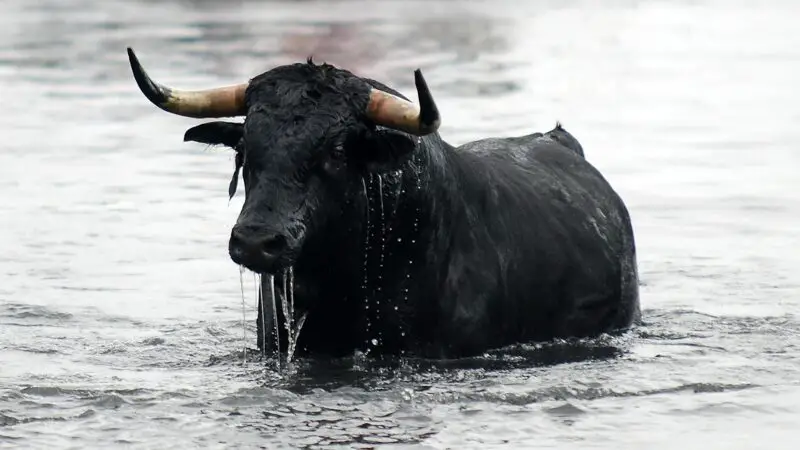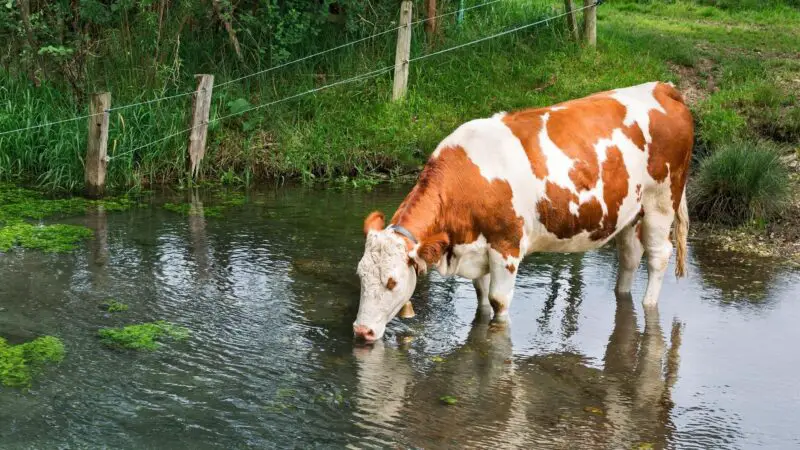Cows and bulls help farmers not only in agriculture but also in the production of milk and dairy products. Cows may be found in a variety of locations across the globe that are rich in water and mud.
Cows and bulls can swim, and they are good swimmers. Even though cows and bulls are large and heavy, they can swim and their powerful leg muscles keep them afloat and moving.
In this article, we will explore how cows and bulls swim, why they enjoy wallowing in mud and spending time in the water.
Do Cows Like Going in Water?

Although cows are not inherently aquatic creatures, they do like spending time near water. They like to swim in water that is not too deep, particularly after they have been out in the sun for a long time.
Are Cows Good Swimmers?
Cows are good swimmers. Even though they are heavy, cows can maintain balance because of their powerful leg muscles.
Related: Can Cows Swim? | Do They Like It!
Does Swimming Come Naturally for Cows?
Cows are not only capable swimmers, but they also seem to enjoy the activity quite a bit. It is a skill that most likely evolved spontaneously since cows and predators both needed to access water at the same time.
Can Baby Cows Swim?
Baby cows can swim. Baby cows are born with their hooves on the bottom of their feet. They can move their legs by kicking them in the water. A calf can even kick its legs underwater.
Can Bulls Swim Underwater?

Bulls can not swim but can float when they are submerged in water. Even if they were able to find a way to immerse themselves, they would instantly reappear on the surface.
Although bulls have the innate ability to swim, they often have no opportunity to do so in captivity.
How Far Can a Cow Swim?
Cows are unable to swim for long distances. However, cows that spend a significant length of time in the water may swim several miles. The two most important factors that contribute to a cow’s endurance are its health and its experience in the water. In times of danger, there have been reports of mature cows that have traveled significant distances.
How Fast Can a Cow Swim?

The typical cow can swim at a pace of around 25 miles per hour (40 kilometers per hour). However, a cow’s ability to swim quickly is dependent on its size. The bigger the cow, the quicker it can swim. Being able to traverse different types of water was a significant survival advantage for the wild ancestors of modern cows.
How Do Cows Swim?
Cows are equally adept at walking and swimming. Their four powerful legs act as paddles to propel them through the water, while their enormous bodies provide them with the density they need to stay afloat. Cows can swim while keeping their heads above the water thanks to their horns, which help tilt their head back and keep it raised, allowing their nose to gasp for air.
Why Do Cows Swim?

For protection against predators and occasionally to cool off on a hot summer day, cows frequently swim and enter the water. Cows also avoid flies and mosquitos, if they are in water their body is covered, and insects cannot reach them.
If they are being grown for their meat, cows may get a great deal of value from including swimming as part of their regular activity. Cows who are allowed to swim regularly have larger muscles which results in meat that is of a higher quality.
Do Cows Drown Easily?
Cows can drown easily because they are so large and they have a difficult time moving their heads when swimming.
In addition, cows have poor eyesight and do not know how deep the water is until they’re already in it. This means that cows often fall into rivers or streams while grazing on land, which is where they typically drown.
How Does the Cow Drown?
Cows often drown because they are exhausted after crossing a long river. Occasionally, they may be quickly drowned due to the water’s pressure.
List of Sources
Using Water to Help Cows with Heat
Get More from Your Milk: Increasing Profit through Value-Added Dairy Food Products
